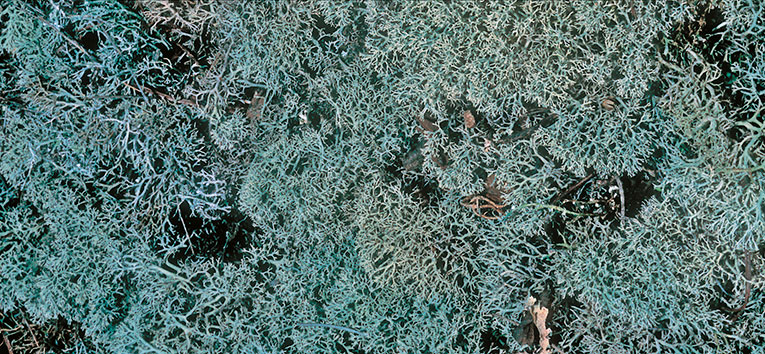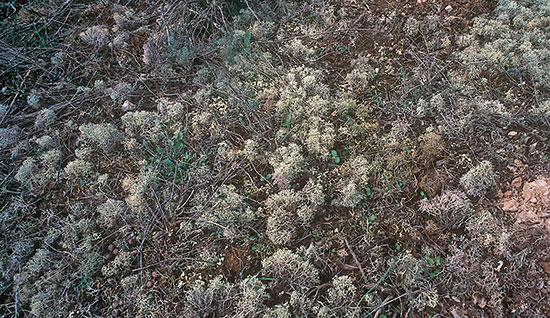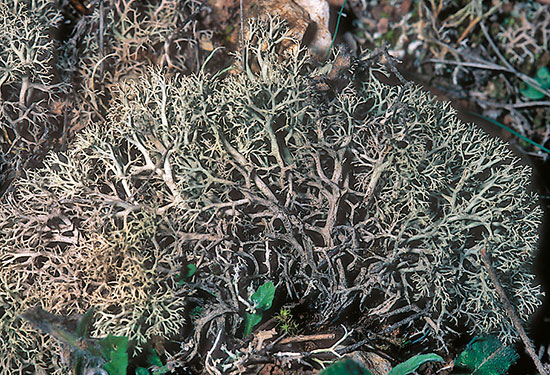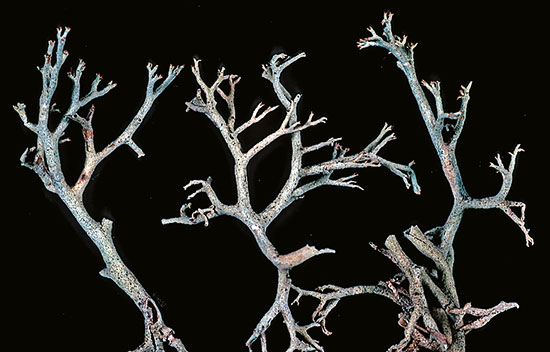 The picture looks like a forest aerial shot, when in fact we are only looking at a close-up shot of lichen. / © Albert Masó & Elizabeth Gallo |
||
|
Nativity sets are usually decorated with moss, which normally belongs to abundant species. However, Nordic countries also use deer lichen, which is very ornamental. When this tradition was introduced in our country, we started collecting a rare species (Cladonia mediterranea) and now this species is endangered. Christmas traditions entail some customs that lead us to wish us peace and happiness. However, some practices are aggressive to our environment. Let’s think, for instance, in how many fir trees are cut down during Christmas, even though there are awareness campaigns to fight against this problem. These initiatives show at least the concerns some have for this problem… but, who thinks about the moss used in Nativity sets? All in all, «it is only a minor plant» some may think. |
«Christmas traditions entail some customs that lead us to wish us peace and happiness. However, some practices are aggressive to our environment» | |
 © Albert Masó & Elizabeth Gallo Typical area for white moss growth— sandy and stony soil in a forest clearing. |
«What is more environment-friendly is encouraging the use of plastic Christmas decorations» | |
|
LICHEN DISGUISED AS MOSS Although it may look like it, white moss is not moss, but a lichen that belongs to the cladoniaceae family (order of lecanorales). This species is one of the most diversified species (almost 400 species) and can have not very visible thallus, from which a very obvious podetium emerges (bearer of the spores). Our lichen belongs to theCladina subspecies —as any other «deer lichen»— characterised by small thallus, and a prolific cap with many branches. It is the most visible one and is not very attached to the ground, up to the point that some gust of wind can detach some pieces, which, propagule-like, spread the species. The profuse ramification (mainly dichotomous) makes them rounded. They have an ivory colour, with yellow-greenish shades. Looked up close, they can look like the top of a tree. Deer lichens have this name because deer feed on these lichens during the long winter months of the Arctic tundras. They are, therefore, resistant to hard climates and some species live in the sandy grounds of taigas, while others live at the Pyrenees. However, our white moss grows in Mediterranean forest clearings and in not very densely populated bushy areas in humid and warm areas, close tot the coast. It does not stand cold winters and lives preferably on poor soils, like shallow, sandy and stony soils. It grows around the Mediterranean area, specially in Catalonia, Ibiza and Formentera, Valencia, Eastern Andalucia, Portugal, Galicia and Southern France |
||
 © Albert Masó & Elizabeth Gallo |
||
|
THE PROBLEM There are many countries that keep the tradition of decorating their nativity sets with moss, but it is usually done using abundant species, which entails almost no risk to the species. In Northern Europe and Scandinavia, however, they also use deer lichen for this purpose. Once collected, they are usually died green (allegedly to make them more appealing) and are chemically treated to make them more flexible. Then, the lichen is exported specially from Finland. To save the money from exports, some traders collect the Iberian species, which is sold mainly in Catalonia. In the month of December it is usual to find boxes of white moss being sold in Christmas markets. The problem is that this is not an abundant subspecies in the Iberian Peninsula as compared to the Arctic tundra. That is way it is an endangered subspecies in some areas. In addition, it has to survive to wildfires. For instance, the population locates at the Creus cape (Catalonia) has been consumed by wildfires in recent years. |
||
 © Albert Masó & Elizabeth Gallo Looked up close we can clearly see that white moss is actually a kind of lichen. |
||
|
THE FUTURE Aside from warning traders not to make off with everything when collecting any kind of plant or mushroom, we can also give some suggestions, like encouraging the use of Christmas plastic decorations. It is more environment-friendly and can be used again and again, so it is more economical. And what if you want a living element? Well then moss of the abundant species should be your choice. Finally, if we want white moss’ future not to be black, the best thing to do is banning its collection and sale, and also declaring it a protected species, unless the environmental sensitivity of our Spanish institutions only reaches animals and «superior» plants. The most advisable thing to do would be applying the same regulations for this lichen that are applied for hollies— only exported shipments can be sold. Xavier Llimona. Full professor of Botany at the University of Barcelona and lichen expert. |
||
© Mètode 2011 - 55. Gene, Ethics and Aesthetics - Issue 55. Autumn 2007





